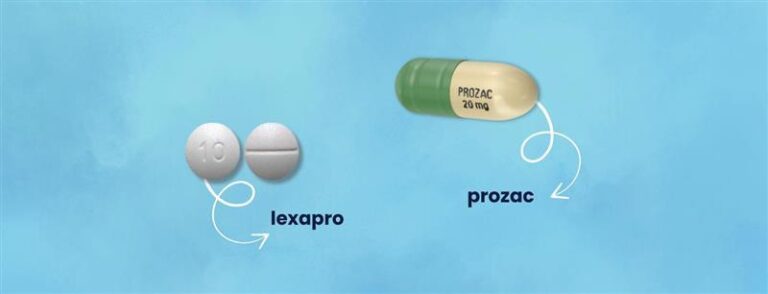SSRIs vs. SNRIs: How These Antidepressants Differ & Which Might Work for You
Choosing an antidepressant can feel overwhelming, especially when you’re already dealing with depression or anxiety. Both SSRIs and SNRIs are commonly prescribed to help regulate mood, but they work differently in the brain and have distinctive side effects. This guide explores how SSRIs and SNRIs differ, supported by peer-reviewed research. What Are SSRIs and SNRIs—And… Read more

Reviewed by Anitha Mathew, NP
Staff Provider at PsychPlus
July 18, 2025

Choosing an antidepressant can feel overwhelming, especially when you’re already dealing with depression or anxiety. Both SSRIs and SNRIs are commonly prescribed to help regulate mood, but they work differently in the brain and have distinctive side effects. This guide explores how SSRIs and SNRIs differ, supported by peer-reviewed research.
What Are SSRIs and SNRIs—And How Do They Work?
SSRIs: Selectively Targeting Serotonin
Selective serotonin reuptake inhibitors (SSRIs) increase the availability of serotonin, a neurotransmitter involved in mood, sleep, and emotional regulation. By inhibiting serotonin’s reabsorption in the brain, SSRIs help alleviate symptoms of depression and anxiety. Common examples include fluoxetine (Prozac), sertraline (Zoloft), and escitalopram (Lexapro).
SNRIs: Broadening the Neurotransmitter Reach
Serotonin-norepinephrine reuptake inhibitors (SNRIs) boost both serotonin and norepinephrine. Norepinephrine plays a critical role in alertness, attention, and stress response. SNRIs like venlafaxine (Effexor) and duloxetine (Cymbalta) are effective not only for depression and anxiety but also for chronic pain conditions such as fibromyalgia and diabetic neuropathy [1].
What Sets Them Apart?
Neurochemical Targets: One vs. Two
SSRIs affect only serotonin, while SNRIs impact both serotonin and norepinephrine. By boosting both neurotransmitters, SNRIs can potentially provide further relief for patients with fatigue, lack of motivation, or pain comorbidities [8].
Onset of Action and Energy Levels
While a 2020 study (and earlier research) found that SNRIs may offer a slightly faster onset of antidepressant effects – possibly due to their influence on norepinephrine and, indirectly, dopamine – many other high-quality studies suggest that both SSRIs and SNRIs can produce an improvement in depressive symptoms within the first week of treatment [17]. While SSRIs tend to have a calming effect, SNRIs may be more activating—a benefit for individuals with low energy or fatigue.
Side Effects
Sexual dysfunction is more prevalent with SSRIs, affecting up to 60% of users [7]. SNRIs share this risk but are also more likely to cause dose-dependent increases in blood pressure, especially venlafaxine [9]. Sexual side effects aren’t exclusive to SSRIs. SNRIs like Effexor XR (venlafaxine) and Cymbalta (duloxetine) can also cause issues such as low libido, anorgasmia, or erectile challenges [15, 16]. If this happens, don’t hesitate to speak with your clinician. A slow medication taper and switching to a different antidepressant class may help ease symptoms while keeping your mental health on track.
SSRIs are generally better tolerated in patients with co-occurring anxiety. In contrast, SNRIs may offer additional benefit for patients with physical symptoms such as back pain or fibromyalgia [1].
Which Is More Effective?
A network meta-analysis found that both SSRIs and SNRIs are effective for Major Depressive Disorder. However, some studies suggest SNRIs like duloxetine and venlafaxine may offer slightly superior efficacy in treatment-resistant cases or when somatic symptoms are present [6][10].
Everyone Responds Differently
There is significant variability in how people respond to antidepressants. Pharmacogenetic factors and baseline symptom profiles can influence outcomes [5]. SSRIs may be better suited for individuals with predominant anxiety symptoms, while SNRIs may be more effective when fatigue or pain co-occur with depression [3].
Treatment Duration and Monitoring
Both SSRIs and SNRIs take 2–6 weeks to produce noticeable effects. Long-term treatment often continues for 6–12 months post-remission. SNRIs, especially venlafaxine, may require regular blood pressure monitoring [9].
Integrated Approaches
Combining Medications with Therapy
Cognitive-behavioral therapy (CBT) in combination with either SSRIs or SNRIs shows superior outcomes compared to medication alone [4].
Lifestyle Support
Exercise, sleep regulation, and nutrition have all been shown to enhance antidepressant response [4]. These lifestyle strategies can be tailored to complement the pharmacological profile of either SSRIs or SNRIs.
Final Thoughts: Choosing Between SSRIs and SNRIs
There is no one-size-fits-all answer; what works for one patient may prove ineffective for another. SSRIs remain a first-line choice for many, especially those suffering from anxiety. SNRIs may be a better fit for patients with treatment-resistant depression accompanied by chronic pain or low energy. A healthcare provider can help tailor treatment based on your health history and symptom profile.
Book Now for Better Mental Health
You don’t have to wait for your mental health to hit a crisis point. Whether you’re navigating depression, anxiety, ADHD, or another condition, online psychiatric care from PsychPlus can help you take control of your wellness. Our board-certified providers will evaluate your unique symptoms and treatment history, providing personalized care —on your schedule, from the comfort of your home.
References
- Arnold, L. M., et al. (2004). A randomized, double-blind, placebo-controlled trial of duloxetine in the treatment of women with fibromyalgia. Arthritis & Rheumatism, 50(9), 2974–2984. https://pubmed.ncbi.nlm.nih.gov/16298061/
- Baldwin, D. S., et al. (2007). The impact of antidepressant treatment on sexual dysfunction: A review. CNS Drugs, 21(4), 239–262. https://pubmed.ncbi.nlm.nih.gov/26519341/
- Bauer, M., et al. (2002). WFSBP guidelines for biological treatment of unipolar depressive disorders. World Journal of Biological Psychiatry, 3(2), 43–113. https://wfsbp.org/wp-content/uploads/2023/02/WFSBP_TG_Unipolar_depressive_disorders_Bauer_et_al_2013.pdf
- Blumenthal, J. A., et al. (2007). Exercise and pharmacotherapy in the treatment of major depressive disorder. Psychosomatic Medicine, 69(7), 587–596. https://pubmed.ncbi.nlm.nih.gov/17846259/
- Bousman, C. A., et al. (2019). Pharmacogenetic tests and depressive symptom remission: A meta-analysis. Journal of Affective Disorders, 252, 423–434. https://pubmed.ncbi.nlm.nih.gov/30520364/
- Cipriani, A., et al. (2018). Comparative efficacy and acceptability of 21 antidepressant drugs: A systematic review and network meta-analysis. The Lancet, 391(10128), 1357–1366. https://www.thelancet.com/article/S0140-6736(17)32802-7/fulltext
- Higgins, A., Nash, M., & Lynch, A. M. (2010). Antidepressant-associated sexual dysfunction: Impact, effects, and treatment. Drug, Healthcare and Patient Safety, 2, 141. https://doi.org/10.2147/DHPS.S7634
- Gaynor, P. J., et al. (2011). Duloxetine versus placebo in the treatment of major depressive disorder and associated painful physical symptoms: a replication study. Current Medical Research and Opinion, 27(10), 1859–1867. https://doi.org/10.1185/03007995.2011.609540
- Papakostas, G. I., & Fava, M. (2007). Tolerability of modern antidepressants. Journal of Clinical Psychiatry, 68(Suppl 10), 914–923. https://pubmed.ncbi.nlm.nih.gov/18494538/
- Papakostas, G. I., et al. (2008). Efficacy of bupropion and the selective serotonin reuptake inhibitors in the treatment of anxiety symptoms in major depressive disorder: A meta-analysis of individual patient data from 10 double-blind, randomized clinical trials. Journal of Psychiatric Research, 42(2), 134–140. https://doi.org/10.1016/j.jpsychires.2007.05.012
- Papakostas, G. I., Thase, M. E., Fava, M., Nelson, J. C., Shelton, R. C., Smith, D., & Trivedi, M. H. (2007). Comparing the rapidity of response during treatment of major depressive disorder with bupropion and the selective serotonin reuptake inhibitors. Journal of Clinical Psychiatry, 68(12), 1907–1912. https://doi.org/10.4088/JCP.v68n1212
- Taylor, Matthew J., et al. (2006.) Early Onset of Selective Serotonin Reuptake Inhibitor Antidepressant Action. Arch Gen Psychiatry, 63(11), 1217-1223. https://pmc.ncbi.nlm.nih.gov/articles/PMC2211759/
- Varigonda, Anjali L., et al. (2015). Systematic Review and Meta-Analysis: Early Treatment Responses of Selective Serotonin Reuptake Inhibitors in Pediatric Major Depressive Disorder. Journal of the American Academy of Child & Adolescent Psychiatry, 54(7), 557-564. https://pubmed.ncbi.nlm.nih.gov/26088660/
- Dr. Eli Muhrer, M.D. “SSRI vs SNRI: Differences, Similarities, and How They Work.” Charlie Health, March 2024. www.charliehealth.com/post/ssri-vs-snri.
- Effexor XR. epocrates.com. https://www.epocrates.com/online/drugs/682/effexor-xr
- Cymbalta. epocrates.com. https://www.epocrates.com/online/drugs/3746/cymbalta
- Li, J., Lu, C., Gao, Z., Feng, Y., Luo, H., Lu, T., Sun, X., Hu, J., & Luo, Y. (2020). SNRIs achieve faster antidepressant effects than SSRIs by elevating the concentrations of dopamine in the forebrain. Neuropharmacology, 177, 108237. https://doi.org/10.1016/j.neuropharm.2020.108237
Find a mental health care provider near you
Learn about the conditions we treat


